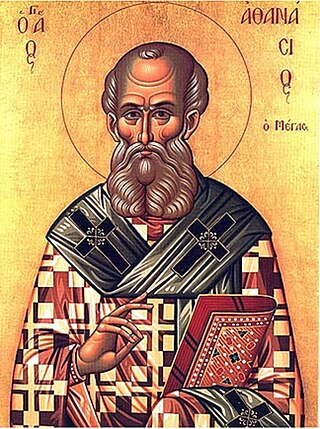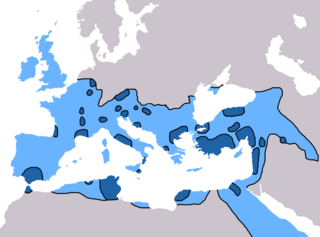Arianism is a Christological doctrine considered heretical by all mainstream branches of Christianity. It is first attributed to Arius, a Christian presbyter who preached and studied in Alexandria, Egypt. Arian theology holds that Jesus Christ is the Son of God, who was begotten by God the Father with the difference that the Son of God did not always exist but was begotten/made before time by God the Father; therefore, Jesus was not coeternal with God the Father, but nonetheless Jesus began to exist outside time.

Athanasius I of Alexandria, also called Athanasius the Great, Athanasius the Confessor, or, among Coptic Christians, Athanasius the Apostolic, was a Christian theologian and the 20th pope of Alexandria. His intermittent episcopacy spanned 45 years, of which over 17 encompassed five exiles, when he was replaced on the order of four different Roman emperors. Athanasius was a Church Father, the chief proponent of Nicene theology against the anti-Nicenes, and a noted Egyptian Christian leader of the fourth century.
Eusebius of Nicomedia was an Arian priest who baptized Constantine the Great on his deathbed in 337. A fifth-century legend evolved that Pope Sylvester I was the one to baptize Constantine, but this is dismissed by scholars as a forgery 'to amend the historical memory of the Arian baptism that the emperor received at the end of his life, and instead to attribute an unequivocally orthodox baptism to him.' He was a bishop of Berytus in Phoenicia. He was later made the bishop of Nicomedia, where the Imperial court resided. He lived finally in Constantinople from 338 up to his death.

The First Council of Nicaea was a council of Christian bishops convened in the Bithynian city of Nicaea by the Roman Emperor Constantine I. The Council of Nicaea met from May until the end of July 325.

Arius was a Cyrenaic presbyter, ascetic, and priest. Traditionally, it was claimed that Arius was the founder of the doctrine of Arianism but, more recently, Rowan Williams stated that "Arius' role in 'Arianism' was not that of the founder of a sect. It was not his individual teaching that dominated the mid-century eastern Church."

Macarius I ; was Bishop of Jerusalem from 312 to shortly before 335, according to Sozomen. He is recognized as a saint within the Orthodox and Catholic churches.

Eustathius of Antioch, sometimes surnamed the Great, was a Christian bishop and archbishop of Antioch in the 4th century. His feast day in the Eastern Orthodox Church is February 21.

Hosius of Corduba, also known as Osius or Ossius, was a bishop of Corduba and an important and prominent advocate for Homoousion Christianity in the Arian controversy that divided the early Christianity.
The Acacians, or perhaps better described as the Homoians or Homoeans, were a non-Nicene branch of Christianity that dominated the church during much of the fourth-century Arian Controversy. They declared that the Son was similar to God the Father, without reference to substance (essence). Homoians played a major role in the Christianization of the Goths in the Danubian provinces of the Roman Empire.
In 294 AD, Sirmium was proclaimed one of four capitals of the Roman Empire. The Councils of Sirmium were the five episcopal councils held in Sirmium in 347, 351, 357, 358 and finally in 375 or 378. In the traditional account of the Arian Controversy, the Western Church always defended the Nicene Creed. However, at the third council in 357—the most important of these councils—the Western bishops of the Christian church produced an 'Arian' Creed, known as the Second Sirmian Creed. At least two of the other councils also dealt primarily with the Arian controversy. All of these councils were held under the rule of Constantius II, who was eager to unite the church within the framework of the Eusebian Homoianism that was so influential in the east.
Marcellus of Ancyra was a Bishop of Ancyra and one of the bishops present at the Council of Ancyra and the First Council of Nicaea. He was a strong opponent of Arianism, but was accused of adopting the opposite extreme of modified Sabellianism. He was condemned by a council of his enemies and expelled from his see, though he was able to return there to live quietly with a small congregation in the last years of his life. He is also said to have destroyed the temple of Zeus Belos at Apamea.

Alexander I of Alexandria was the 19th Pope and Patriarch of Alexandria. During his patriarchate, he dealt with a number of issues facing the Church in that day. These included the dating of Easter, the actions of Meletius of Lycopolis, and the issue of greatest substance, Arianism. He was the leader of the opposition to Arianism at the First Council of Nicaea. He also mentored his successor, Athanasius of Alexandria, who would become one of the Church Fathers.
The Council of Serdica, or Synod of Serdica, was a synod convened in 343 at Serdica in the civil diocese of Dacia, by Emperors Constans I, Augustus in the West, and Constantius II, Augustus in the East. It attempted to resolve "the tension between East and West in the Church." “The council was a disaster: the two sides, one from the west and the other from the east, never met as one.”
The Arian controversy was a series of Christian disputes about the nature of Christ that began with a dispute between Arius and Athanasius of Alexandria, two Christian theologians from Alexandria, Egypt. The most important of these controversies concerned the relationship between the substance of God the Father and the substance of His Son.
The Melitians, sometimes called the Church of the Martyrs, were an early Christian sect in Egypt. It was founded soon after the end of the Great Persecution (313) by Bishop Melitius of Lycopolis. It survived as a small group into the eighth century. The point on which they broke with the larger church was the same as that of the contemporary Donatists in the province of Africa: the ease with which lapsed Christians were received. The resultant division in the church of Egypt is known as the Melitian Schism, to be distinguished from the Meletian Schism later that same century.
The Councils of Alexandria started in 231 AD as a council of bishops and priests met at Alexandria, Egypt, called by Bishop Demetrius for the purpose of declaring Origen of Alexandria unworthy of the office of teacher, and of excommunicating him.

Christianity in the 4th century was dominated in its early stage by Constantine the Great and the First Council of Nicaea of 325, which was the beginning of the period of the First seven Ecumenical Councils (325–787), and in its late stage by the Edict of Thessalonica of 380, which made Nicene Christianity the state church of the Roman Empire.

Constantine the Great's (272–337) relationship with the four Bishops of Rome during his reign is an important component of the history of the Papacy, and more generally the history of the Catholic Church.
Arian creeds are the creeds of Arian Christians, developed mostly in the fourth century when Arianism was one of the main varieties of Christianity.
Theodotus was the bishop of Laodicea in Syria from the early 300s. He replaced Stephen, who apostasized during the Great Persecution (303–313). The exact year of his consecration cannot be fixed more precisely. He attended at least four church councils.








